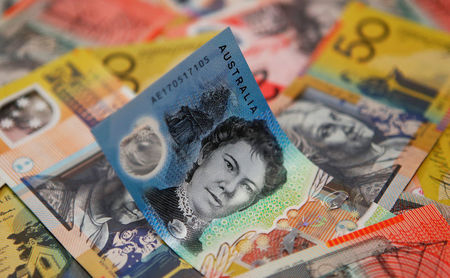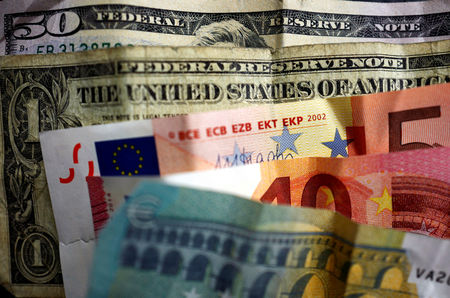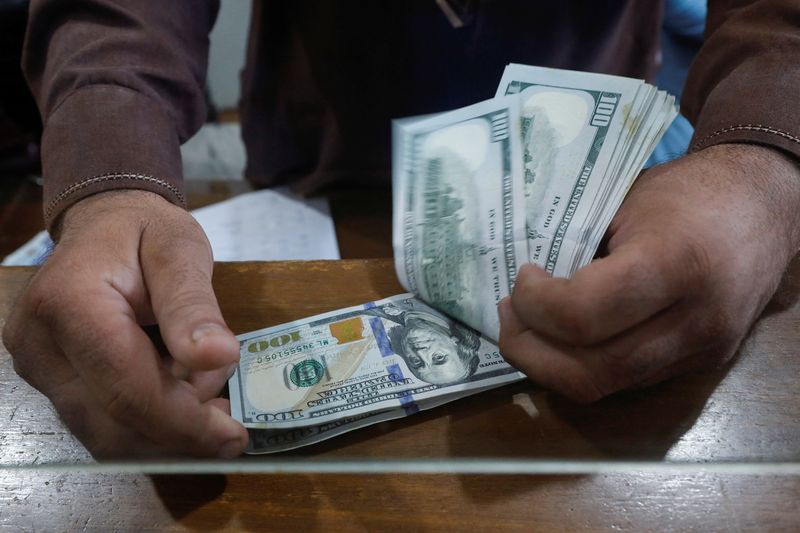Forex
Explainer-Why is the Japanese yen so weak?

SINGAPORE (Reuters) – Japan’s yen is at three-decade lows and under enough pressure to prompt strong official warnings of intervention to prop it up.
The yen has fallen despite Japan’s first interest rate hike since 2007 and optimism about the economy. It traded at 153.24 per dollar on April 10, its weakest since 1990 and in real terms it is at its weakest since at least the 1970s.
A weaker yen is a boon for Japanese exporters’ profits, and for tourists visiting Japan who find their currencies going further, but it squeezes households by increasing import costs.
Here are some of the reasons for the slide:
RATES
Interest rates and momentum are powerful forces in foreign exchange markets. Both are against the yen. The yen has been steadily falling for more than three years and has lost about a third of its value since the start of 2021.
The yen is also the lowest-rate, or yielding, G10 currency. That means investors are borrowing it cheaply and selling it to invest in higher-yielding currencies, driving its price down.
These deals, known as a “carry trades” are particularly attractive when broader market volatility is low, as it is right now, as the fundamental rate difference drives markets.
Short-term Japanese rates are held below 0.1% and are not expected to rise much further.
Short-term U.S. rates are at 5.25-5.5% and a U.S. rate cut isn’t expected until September or November.
The U.S.-Japan government bond yield gap at the 10-year tenor is almost 370 bps.
RELOAD
Japan’s central bank made a historic shift out of negative interest rates in March. But the move was so well advertised, and has not put future sharp hikes on the table, leaving investors comfortable to add to short yen positions.
Yen shorts, by value, hit a decade high in April.
The rates picture is also keeping big Japanese investors’ cash abroad, where it can earn better returns.
Japan Post Bank and Japan Post Insurance, among the largest financial firms, told Reuters their portfolios won’t be radically changing in response to the BOJ’s policy shift.
RESPONSE
The yen’s dollar exchange rate has broken the level that drew intervention in 2022 and markets are on edge about the potential for government yen buying in support of the currency.
Finance Minister Shunichi Suzuki pledged “decisive action” against speculative moves late in March, language that preceded previous yen-buying intervention. Traders are now focused on the 153 to 155 range as an intervention red zone.
REAL TERMS
A real effective exchange rate index value of 70.25 for the yen in February is the lowest since the Bank of International Settlements’ records began in 1994 and lower than any of the Bank of Japan’s retrospective projections, which date to 1970.
That means tourist dollars go further than they have for generations and has tourism booming. Japan’s current account has been in surplus for 13 months with help from tourism income and February’s 2.79 million visitors was a record for the month.

Domestic consumption, however, has been a weak spot in Japan’s fragile economic recovery as households tend to be net importers and face higher prices due to a weak yen.
Beyond Japan, some analysts say the yen’s weakness threatens to erode the competitive advantage of Chinese manufactures, and speculate it could be behind recent falls in the yuan – though authorities in China maintain a close grip on the currency.
Forex
UBS maintains RBA rate cut forecast, weighs in on AUD/USD

On Thursday, UBS provided insights into the Australian Federal Treasurer Jim Chalmers’ third budget announcement, which reported a second consecutive surplus of AUD 9.3 billion.
Despite this positive outcome, UBS highlighted a projected deficit of AUD 28.3 billion for the fiscal year 2024-25, a figure that is wider than the Treasury’s earlier forecasts.
The firm pointed out that the deficit projection for 2024-25 might be based on overly conservative commodity price assumptions.
UBS suggests that commodity prices are likely to remain higher than anticipated, which could lead to upward fiscal revisions in the future. This outlook is based on details found in the footnotes of the budget document.
In light of the budget details, UBS confirmed that their expectations for the Reserve Bank of Australia’s (RBA) monetary policy remain unchanged. They continue to forecast a 25 basis points cut in the cash rate in February 2025.
Moreover, UBS anticipates that the Australian dollar will maintain its higher trading range against the US dollar, fluctuating between 0.65 and 0.675.
The budget surplus achieved this year contrasts with the anticipated deficit for the next fiscal year. This shift reflects the dynamic nature of Australia’s economic landscape and the challenges that may arise in the medium term. UBS’s analysis suggests that the budget’s implications have been thoroughly considered and have not altered their long-term economic forecasts for Australia.
UBS’s commentary provides a focused perspective on the fiscal situation in Australia, without implying broader economic trends or industry-wide impacts. The firm’s projections are specific to their analysis of commodity prices and the anticipated actions of the RBA, taking into account the latest federal budget details.
remove ads
.
This article was generated with the support of AI and reviewed by an editor. For more information see our T&C.
Forex
Dollar stabilizes after sharp CPI-induced fall; euro hands back some gains

Investing.com – The U.S. dollar steadied in European trade Thursday, after dropping to multi-week lows overnight in the wake of a milder U.S. inflation report, which brought Fed rate cuts back into focus.
At 04:25 ET (08:25 GMT), the Dollar Index, which tracks the greenback against a basket of six other currencies, traded 0.1% higher at 104.285, having fallen to a five-week low just below 104 overnight.
Dollar on back foot after key inflation data
The dollar remains on the back foot after the latest U.S. inflation data raised expectations the will deliver two interest rate cuts this year, probably starting in September.
Wednesday’s rose by 0.3% in April, below an expected 0.4% gain, which came as a relief to markets after sticky consumer prices in the first quarter had led to a sharp paring of rate cut bets and even stoked some worries of an additional hike.
The data also resulted in U.S. Treasury yields sinking to six-week troughs, as traders reassessed the likely path of the Fed’s monetary policy.
“Markets have given a greater weight to the encouraging news coming from two days of inflation figures, which has caused the dollar to almost entirely erase the gains after the CPI disappointment in mid-April,” said analysts at ING, in a note.
There are a number of Fed speakers due to opine later in the session, but it’s likely investors will need concrete evidence if rate cut expectations are to be changed drastically from now.
remove ads
.
“Our preferred call at this stage is not for a continuation of a dollar decline until the end of May, but instead a period of quiet trading with little sense of direction and low volatility. That’s mainly because hard data is needed to move the needle substantially on Fed pricing, and the next key release – core PCE – is only on 31 May,” ING added.
Euro retreats from earlier highs
In Europe, traded 0.1% lower to 1.0867, with the euro retreating slightly Thursday after earlier climbing to its highest since March 21.
The is widely expected to start cutting interest rates from a record high in June, and markets now see up to three rate cuts this year, or two beyond June, most likely in September and December.
“The 1.0900 level should not be a very strong resistance if U.S. data – for example, jobless claims today – adds pressure on the dollar. However, a move to the 1.1000 benchmark levels seems premature given the still sticky inflation picture in the U.S.,” ING said.
fell 0.1% to 1.2675, with sterling handing back some of the previous session’s gains when it climbed above 1.27 for the first time since April 10.
The is also expected to cut rates from a 16-year high this summer, but recent stronger than expected GDP growth could delay this until after the ECB moves.
Yen posts minor gains after weak GDP data
In Asia, fell 0.2% to 154.64, with the yen benefiting from the dollar’s weakness, but the pair remained well above levels hit earlier in May, when the government was seen intervening in currency markets.
remove ads
.
The yen’s recovery stalled as data showed the Japanese economy shrank much more than expected in the first quarter, raising doubts over just how much headroom the Bank of Japan has to keep raising interest rates.
traded largely flat at 7.2187, as sentiment towards China remains weak after Washington imposed stricter trade tariffs on China’s key industries, such as electric vehicles, medicines and solar technology.
Forex
Yen climbs while dollar stabilises after US inflation ebbs

By Harry Robertson and Tom Westbrook
LONDON/SINGAPORE (Reuters) – The Japanese yen rallied for a second day on Thursday after data on Wednesday showed a slowdown in U.S. inflation, while the dollar found a footing against other currencies following a sharp drop the previous day.
U.S. inflation slowed to 0.3% in April from a month earlier, down from 0.4% in March and below expectations for another 0.4% reading, Wednesday’s data showed.
Year-on-year core inflation – which strips out volatile food and energy prices – fell to its lowest in three years at 3.6%. Meanwhile, retail sales were flat, suggesting conditions for Federal Reserve interest rate cuts are falling into place.
The dollar dropped 1% against the yen on Wednesday after the data and was down a further 0.38% on Thursday at 154.32, having fallen as low as 153.6 before weak Japanese growth figures took some of the shine off the yen.
The Japanese currency has fallen around 9.5% this year as the Bank of Japan has kept monetary policy loose while higher Fed interest rates have drawn money towards U.S. bonds and the dollar. The yen has been particularly sensitive to any widening or closing of the interest rate differential.
The , which tracks the currency against six major peers, was last up 0.11% at 104.32 on Thursday after falling 0.75% on Wednesday as investors raise their bets on Fed rate cuts, now envisaging two reductions by the end of the year.
Some analysts said Fed officials will want to see proof of inflation’s downward path before countenancing cuts, a point made by Minneapolis Fed President Neel Kashkari on Wednesday.
remove ads
.
Francesco Pesole, FX strategist at ING, said: “In practice there isn’t all that much to be all that optimistic about. Inflation is moving in the right direction but still not at levels that would allow the Fed to cut rates.”
Pesole said investors were now waiting for U.S. personal consumption expenditures inflation data in late May. “My view at this stage is that we could just default to another couple of weeks of low volatility, lack of direction, and range-bound trading.”
The euro hit a two-month high at $1.0895 on Thursday before dipping to trade 0.1% lower at $1.0874. Britain’s pound reached a one-month top of $1.2675 before falling back slightly.
The Australian dollar, which surged 1% on Wednesday, hit a four-month high at $0.6714 but then paused after an unexpected rise in Australian unemployment.
It was last at $0.6684 as traders priced out any risk of a further rate hike in Australia.
touched a three-week high of $66,695 before dipping slightly.

 Forex2 years ago
Forex2 years agoForex Today: the dollar is gaining strength amid gloomy sentiment at the start of the Fed’s week

 Forex2 years ago
Forex2 years agoHow is the Australian dollar doing today?

 Forex1 year ago
Forex1 year agoUnbiased review of Pocket Option broker

 Forex2 years ago
Forex2 years agoDollar to pound sterling exchange rate today: Pound plummeted to its lowest since 1985

 Cryptocurrency2 years ago
Cryptocurrency2 years agoWhat happened in the crypto market – current events today

 World2 years ago
World2 years agoWhy are modern video games an art form?

 Stock Markets2 years ago
Stock Markets2 years agoMorgan Stanley: bear market rally to continue

 Economy2 years ago
Economy2 years agoCrude oil tankers double in price due to EU anti-Russian sanctions

































